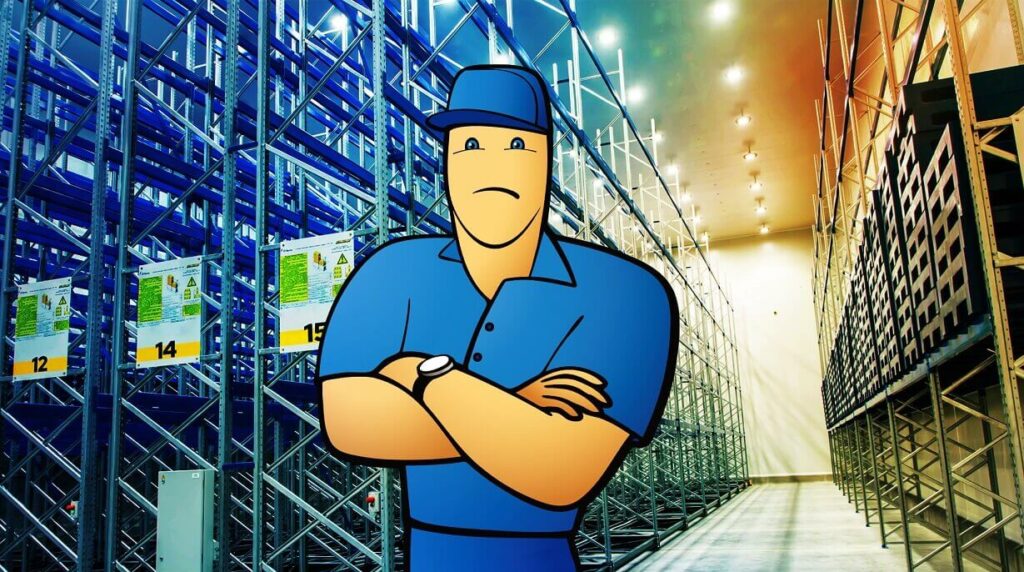What are Stockouts and How to Prevent Them?
While stockouts may suggest that a product is popular, they are typically costly mistakes in inventory management that are far better avoided than managed after the fact. In this article, we look at what stockouts are, how they are caused, and what businesses can do to prevent them.

You can also listen to this article:
What is a stockout?
A stockout is when an inventory item that has demand is out of stock. In other words, stockouts are situations in which raw materials, subassemblies, or finished products with no inventory level have outstanding manufacturing or customer orders.
Stockout is the opposite of overstocking – a situation where an inventory item has a considerably higher stock level than there is demand for it. Stockouts are the bane of manufacturers, distributors, and retailers alike because they can create serious supply chain disruptions, bottleneck manufacturing cycles, and hamper fulfillment.
Stockouts vs out of stock vs backorder
Technically, items with no stock level do not constitute a stockout unless incoming manufacturing or customer orders create demand for them. Out-of-stock items (OOS) can be made available for sale or booked into manufacturing orders before they are in stock, presuming an adequate level of stock control.
In the case of finished goods, this would be called available on backorder – a situation where goods can be included in sales orders before they are in stock. This presumes a capable sales management system able to account for OOS items. Retailers and distributors should take care as supply chain logistics get more complicated when back-ordering is allowed.
OOS items can also still be useful in production orders or work in process. These would be purchased materials or sub-assemblies that are expected in stock but have yet to arrive. With the aid of a capable MRP system, for example, expected items can be booked into MOs beforehand. Neither of the above situations would constitute a stockout.
Common causes of stockouts
Stockouts can be caused by many different reasons, chief among which are poor forecasting, inventory management issues, and supply chain disruptions. While in many cases, stockouts can be minimized or eliminated by preemptive planning, they can also arise quickly from sudden supply chain issues or demand surges. Let’s go over some common causes of stockouts.
Poor cash flow management
Poor cash flow management can significantly contribute to stockouts. When businesses do not have sufficient liquidity, they may be forced to delay purchasing new stock which can lead to shortages. This situation is often made worse by poor financial planning or unexpected expenses that can strain the budget. Inadequate cash flow can also prevent a business from taking advantage of bulk purchasing discounts or emergency restocks.
Low inventory optimization
Low inventory optimization and keeping inaccurate inventory records are major causes of stockouts. When inventory data is not regularly updated or discrepancies are not quickly addressed, businesses can end up with either excess stock or stockouts. Poor inventory optimization can result from inefficient warehouse management, lack of integration between inventory systems, human error, or other reasons.
Inefficient order management
Delays in order processing, fulfillment errors, or miscommunication between departments can also result in inventory being depleted faster than it is replenished. If a customer order isn’t recorded properly, for example, the inventory manager may not be prompted to replenish stock, resulting in an unexpected stockout down the line. Streamlining order processing workflows and implementing lean warehouse management practices can help mitigate these stockout risks.
Bad supplier performance
Bad supplier performance is another critical factor that may lead to stockouts. Suppliers who fail to deliver on time, provide poor-quality goods, or frequently change their terms can disrupt the supply chain and lead to constant inventory shortages. Businesses relying heavily on a single supplier are particularly vulnerable to these issues.
Establishing strong relationships with reliable suppliers, diversifying the supplier base, and regularly evaluating supplier performance can help address these risks.
Low demand forecasting accuracy
Another regular culprit of stockouts is poorly conducted demand forecasting. Inaccurate forecasts can stem from using outdated data, failing to account for market trends, or not integrating customer feedback into the forecasting process. When demand is underestimated, businesses might not stock enough products to meet customer needs, leading to stockouts. Automated analytics or master production schedules can help increase forecasting accuracy.
Logistics issues
Supply chain disruptions can cause sudden and unexpected inventory problems, stockouts included. These disruptions can result from political instability, transportation issues, sudden changes in regulatory policies, etc. The interconnectedness of modern global supply chains means that a disruption in one part of the world can have regional or even global ripple effects.
To mitigate the impact of supply chain disruptions, businesses should develop contingency plans, take a preemptive approach to supplier performance management, and invest in supply chain visibility tools.
Sudden demand surges
Driven by seasonal trends, promotional activities, or unexpected market events, sudden demand surges can often lead to stockouts. When customer demand unexpectedly spikes, businesses may struggle to replenish inventory quickly enough to meet customer needs. This can result in lost sales and customer dissatisfaction.
To manage sudden demand surges, businesses should employ flexible inventory strategies such as safety stock or just-in-time inventory systems. Analyzing historical sales data and monitoring market trends can further help anticipate and prepare for potential spikes.
The impacts of stockouts
Stockouts can impact a business in different ways. In all cases, however, they ultimately affect customer retention and brand reputation. Here are some of the negative consequences stockouts can bring for companies:
- Lost sales and revenue. Stockouts result in a loss of sales as customers turn to competitors to fulfill their needs. This directly impacts revenue and can affect future sales due to the now decreased customer loyalty. A consistently high stockout rate can significantly erode market share and weaken the financial stability of companies.
- Increased operational costs. Next to lost revenue, stockouts also bring extra costs in the form of expedited shipping fees, overtime wages, emergency restocking expenses, etc. All of these strain budgets and reduce overall profitability.
- Decreased customer satisfaction. Product availability is a major marker of customer satisfaction. Stockouts significantly impact this, leading to frustration and dissatisfaction when products are unavailable. This can result in negative reviews, decreased customer loyalty, and a reduction in repeat business.
- Refunds and backorder costs. Next to increased operational costs, stockouts often necessitate refunds or managing backorders which incur additional costs and administrative burdens. Handling these can be time-consuming and expensive, further straining resources. Frequent stockout situations and unplanned backorders damage profitability and complicate inventory management.
- Impact on company reputation. Consistent stockouts can damage a manufacturing or retail business’s reputation. This can affect relationships with direct customers, retail partners, stakeholders, and suppliers.
- Disrupted production schedules. Stockouts of essential raw materials or components can cause significant disruptions in production scheduling, leading to delays and increased downtime. This affects a manufacturer’s output and can have a cascading effect on subsequent production cycles.
How to calculate stockout cost?
Quantifying the negative impact of stockouts is essential for understanding the financial burden they entail. There are informative ways to go about this. For example, any expedited shipping costs or overtime labor incurred from a stockout can simply be summed together. This also goes for transaction fees and administrative work from handling refunds or backorders.
A prominent metric for calculating stockout cost would be Lost Sales Value which indicates the amount of revenue lost for a Stock Keeping Unit (SKU) with outstanding demand. To calculate LSV, multiply the selling price per unit of the article by the number of units not sold due to a stockout. Finding the latter can be achieved by multiplying average sales numbers for the item by the length of the stockout.
Lost sales value = Average sales per day x length of the stockout in days x price per unit
For example, if the average sales per day for an item is 10 units, the stockout lasts for 5 days, and the selling price per unit is $40, the lost sales value would be:
Lost sales value=10×5×40=$2,000
How to prevent stockouts?
As we have seen, preventing stockouts is crucial for maintaining high customer satisfaction, maintaining optimal production capacity, and ensuring a smooth operation. To end this article, let’s look at some effective methods to prevent stockouts and maintain optimal inventory levels.
Utilize safety stock and reorder point (ROP)
Safety stock is extra inventory held to prevent stockouts in case of unexpected demand surges or supply delays. It acts as a buffer against demand and supply uncertainties. To determine the optimal level of safety stock, businesses should analyze historical sales data, forecast demand variability, and consider lead times. Analyzing production or sales data can help calculate appropriate safety stock levels.
A reorder point (ROP) is the inventory level at which new stock should be ordered to replenish the inventory before it runs out. It is calculated based on an item’s lead time and demand rate, plus its safety stock level, if applicable. Setting accurate reorder points allows businesses to ensure and partially automate inventory replenishment.
Optimize supplier and supply chain management
Effective supplier management is crucial in preventing stockouts. Building strong relationships with reliable suppliers ensures a timely and consistent supply of goods. Diversifying the supplier base can mitigate the risk of relying on a single supplier, which can lead to supply chain disruptions if the supplier fails to deliver. Businesses should regularly evaluate supplier performance based on criteria such as on-time delivery, quality, and flexibility.
Managing logistical challenges is also essential in preventing stockouts. This includes optimizing logistics, supply chain planning, maintaining clear communication with suppliers and logistics providers, etc.
Increase demand forecasting accuracy
Accurate demand forecasting is critical for maintaining optimal inventory levels and preventing stockouts. Effective forecasting involves analyzing historical sales data, market trends, and seasonality to predict future demand. Advanced analytics and machine learning models can enhance forecasting accuracy by identifying patterns and making data-driven predictions.
Production planning software can play a significant role in improving forecasting accuracy. These tools integrate various data sources, provide real-time insights, and facilitate collaboration across departments. By leveraging this type of software, businesses can create more accurate forecasts and align inventory levels with actual demand, thus reducing the likelihood of stockouts.
Increase inventory accuracy and traceability
Inaccurate inventory data can lead to incorrect stock levels, resulting in either excess inventory or stockouts. Implementing modern inventory management systems can help businesses achieve higher inventory accuracy by automating data entry and integrating inventory with sales and procurement.
Traceability is also crucial in inventory management. By tracking inventory throughout the supply chain, businesses can quickly identify and address discrepancies, ensuring that stock levels are accurately reflected. Advanced inventory management systems offer features such as barcode scanning and RFID technology, reducing the risk of stockouts by providing system-wide visibility on stock movements.
Implement continuous improvement practices and Just-In-Time (JIT)
Continuous improvement (CI) practices, such as lean inventory management, Six Sigma, and other CI models can help businesses further refine their inventory processes. For example, lean inventory management focuses on reducing waste and optimizing inventory levels, ensuring that businesses maintain just the right amount of stock.
Just-In-Time (JIT) inventory management is another effective strategy for preventing stockouts. JIT aims to reduce inventory holding costs by receiving goods only as they are needed in the production process, thereby minimizing inventory levels. Implementing JIT requires close coordination with suppliers and a well-managed supply chain to ensure timely deliveries. Continuous improvement and JIT practices foster a proactive approach to inventory management, enhancing overall operational efficiency and reliability.
Implement inventory management software
Implementing a robust inventory management software (IMS) is one of the most effective ways to prevent stockouts. A good IMS centralizes inventory data, automates reorder processes, and integrates with other business systems, such as manufacturing and purchasing. This ensures that inventory levels are aligned with production scheduling and supplier lead times.
An IMS can also calculate optimal safety stock levels, set automated reorder points, and provide real-time visibility into inventory status. It can leverage advanced analytics to improve demand forecasting and offer insights into inventory performance. By centralizing stock counting and providing accurate lead time calculations, an IMS is by far the most powerful single tool to help businesses maintain optimal inventory levels and minimize the risk of stockouts.
Key takeaways
- A stockout is when an inventory item with demand is out of stock, causing supply chain disruptions and fulfillment issues.
- Stockouts are distinct from out-of-stock items, as they specifically refer to situations where demand exists but inventory is unavailable.
- The main causes of stockouts include poor cash flow management, low inventory optimization, inefficient order management, bad supplier performance, low demand forecasting accuracy, logistics issues, and sudden demand surges.
- It’s important to quantify the cost of stockouts to understand their financial impact, including lost sales value, increased operational costs, and handling refunds or backorders.
- Preventing stockouts is crucial for maintaining customer satisfaction, ensuring smooth operations, and safeguarding business profitability. Effective strategies include utilizing safety stock and reorder points, optimizing supplier management, increasing demand forecasting accuracy, enhancing inventory accuracy and traceability, and using robust inventory management software.
Frequently asked questions
Stockouts are serious because they lead to lost sales, decreased customer satisfaction, and potential damage to reputation. They also increase operational costs due to expedited shipping, overtime wages, and handling refunds or backorders. They disrupt business operations and can significantly impact profitability.
Several factors including poor demand forecasting, inadequate inventory management, supplier delays, sudden demand surges, and logistical issues can cause stockouts. Inaccurate inventory records and inefficient order processing can also contribute.
The cost of a stockout includes lost revenue from missed sales, increased operational expenses such as expedited shipping and overtime, and the administrative costs of handling refunds and backorders. Additionally, stockouts can result in long-term costs due to decreased customer loyalty and potential damage to the company’s reputation.
Balancing holding costs with the risk of stockouts involves finding the optimal inventory level that minimizes both costs and risks. Implementing just-in-time (JIT) inventory practices and utilizing advanced inventory management software can help achieve this balance by ensuring timely restocks without overburdening storage. Regularly reviewing and adjusting safety stock levels based on demand variability and lead times also aids in optimizing inventory levels effectively.
You might also like: 9 Warning Signs Your Manufacturing Company Needs MRP Software




